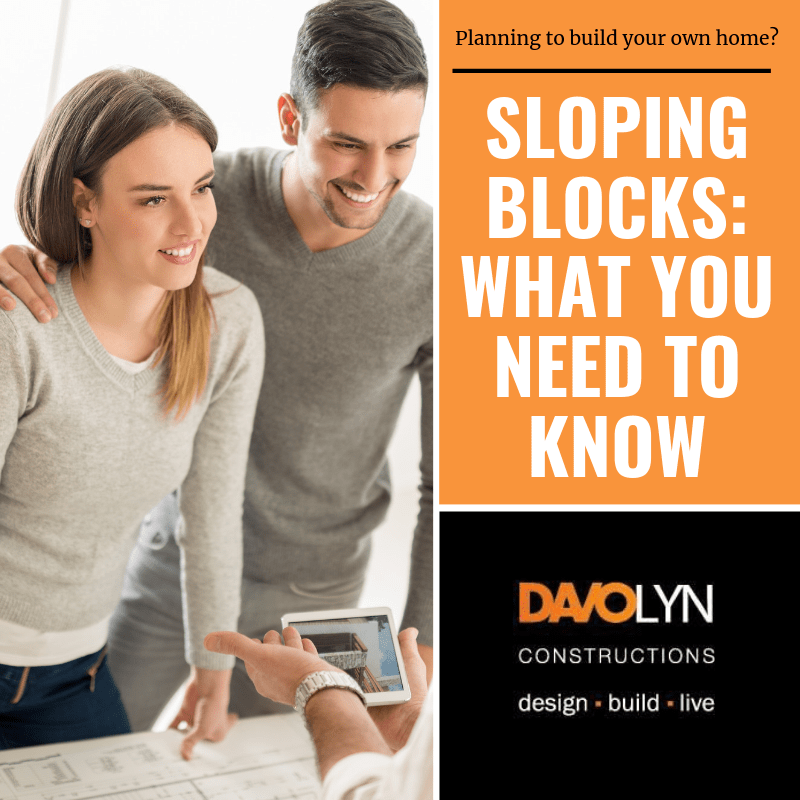In order to achieve a beautiful view, unique house design, and sturdy foundation – builders working on sloping blocks must be innovative and creative.
Why?
This is because building on a sloping block can be problematic and difficult. Thus, it can become more expensive than a normal flat site, if you are not working with skilled and professional builders in Plainland and Gatton.

Here at Davolyn Construction, we take on these challenges at heart. Our years of experience in constructing in sloping blocks gives you the assurance that your home is built strong as you have dreamed of it.
But before you get excited on how we are going to build your dream house on a sloping block, here are some of the things you need to know about sloping blocks.
What is a sloping block?
Sloping block is a land characterised by slopes that can either be inclining or declining. They have uneven elevations making it hard to build a steady foundation on it, if and only if you don’t have the skills and knowledge.
But why is it preferred by many homeowners? Here are some of the advantages that a sloping block can bring:
- Creative house design plus landscape gardens
- Breathtaking views
- Natural ventilation and drainage
- Natural lighting
With these benefits, who wouldn’t love the idea of building their dream home on a building block? The only problem is to find that right builder who can make your dream a reality.
Things to consider before designing and construction
A skilled builder in Gatton or Plainland knows that the following has to be carefully planned to ensure a sturdy sloping block dream house:
Ground condition
A soil test must be performed by a geotechnical engineer in order to check the stability of the ground before construction. This can give you a go signal or make you think twice with your plans.
What will the soil test reveal?
If the soil has too much moisture in it, the moisture build-up can happen which can put pressure on the structure due to dampness. If there are rocks, then excavation will be needed – which is costly and tedious.
Access
Analysing the access to a sloping block is significant to the construction’s success. This guarantees safe passage to pedestrians and construction vehicles to the site. It also allows you to decide where to face your home’s entries and driveway.
Topography
Topography analyses the contour and features of the block you chose to construct on. It also checks the natural formations around the block. This helps you calculate and solution the dangers and possibilities of soil erosion and landslides.
Analysis of the block
Site analysis is important in every kind of construction. Whether it’s on a flat site or sloping block.
Site analysis for a sloping block can identify potential issues to encounter such as:
- Drainage corridors
- Access
- Degree and direction of the slope
- Potential views
- Natural features of the land
All of these are important factors before starting any construction on your sloping block. Thus, it is important to work with someone who has knowledge in land analysation. Talk to us.
Extremity and direction of the slope
Some blocks have different types of slopes. Some slopes are going upward, while some are downward. Other blocks have slopes on each side. The extremity and direction of the slope allows the builders to picture out how to design your home that suits it. It also allows the builder to know how challenging and how costly the project can be.
After considering the ground condition, access, etc. – here are the five things you need to do correctly to make sure that you’ll survive the curse of sloping blocks.
Five things to do to avoid the nightmare
1. Make the most out of the orientation
Work with your builder carefully and place your windows and doors at the appropriate place. Make sure to maximise your view and the natural light in your area.
2. Builder’s experience is necessary
Your builder’s experience with dealing sloping blocks is significant to the success of the project. Make sure they have enough of it before settling with them. Have a background check. Ask their previous clients with the sloping block homes about their experience with that builder.
3. Work on the foundation
Expert builders will know what type of foundation will suit your dream house and your sloping area. Need not to settle with the typical designs.
4. Find the hidden benefit of the slope
As you decide to go forward with your sloping block – better make sure to find any hidden benefit from it. Make sure to plan out your block carefully and thoughtfully to ensure that no space is left behind. List down the potential designs that the block can be used.
5. Rock = excavation
With sloping blocks, you are likely to face a rock. Make sure to eliminate any unneeded and costly excavation.
Does it need to be costly?
The gradient on the slope tells how challenging and costly your plan is. You should consider the direction of the slope to make sure which options are better. Be open and plan thoughtfully with your designers and builders. They can guide you on how you can achieve your dream house while reducing the cost of construction.
Contact Davolyn Constructions
For further assistance, call 0409 661 655